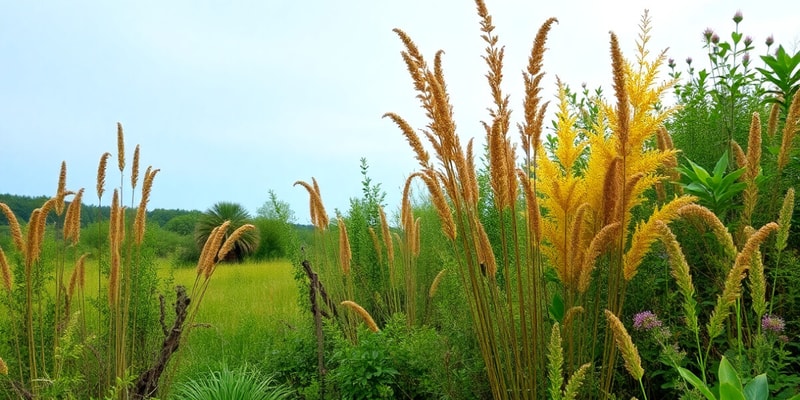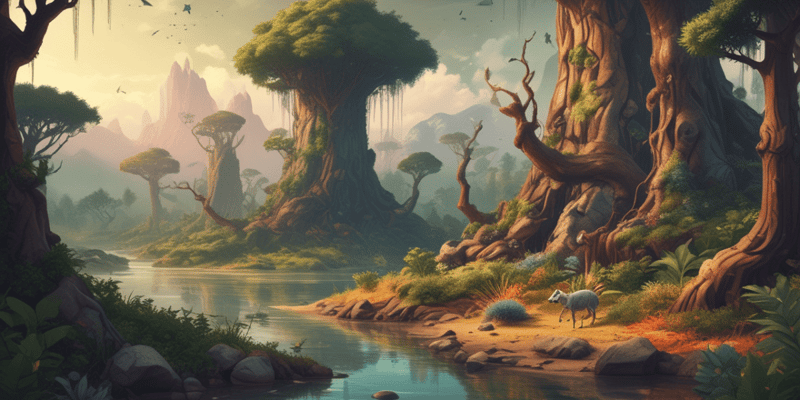Podcast
Questions and Answers
What is a characteristic of urban ecosystems?
What is a characteristic of urban ecosystems?
What impact do modern agricultural practices have on ecosystems?
What impact do modern agricultural practices have on ecosystems?
How do rural ecosystems often influence the landscape?
How do rural ecosystems often influence the landscape?
Which type of ecosystem is defined as being built primarily by animals?
Which type of ecosystem is defined as being built primarily by animals?
Signup and view all the answers
What is a significant feature of agroecosystems?
What is a significant feature of agroecosystems?
Signup and view all the answers
Which characteristic is typical of temperate zones' biodiversity?
Which characteristic is typical of temperate zones' biodiversity?
Signup and view all the answers
What is one reason for leaf coloration changes in the fall?
What is one reason for leaf coloration changes in the fall?
Signup and view all the answers
Which of the following is a defining feature of boreal forests?
Which of the following is a defining feature of boreal forests?
Signup and view all the answers
Which characteristic is NOT typically associated with temperate rainforests?
Which characteristic is NOT typically associated with temperate rainforests?
Signup and view all the answers
What environmental factor primarily limits tree growth in chaparral biomes?
What environmental factor primarily limits tree growth in chaparral biomes?
Signup and view all the answers
In what type of ecosystem would you find high productivity and biomass alongside complex vertical structures?
In what type of ecosystem would you find high productivity and biomass alongside complex vertical structures?
Signup and view all the answers
Which adaptation is common for plants in desert ecosystems to cope with arid climates?
Which adaptation is common for plants in desert ecosystems to cope with arid climates?
Signup and view all the answers
What role do large herbivores play in the tropical savanna ecosystem?
What role do large herbivores play in the tropical savanna ecosystem?
Signup and view all the answers
Which factor contributes to the diurnal temperature fluctuations in evergreen tropical rainforests?
Which factor contributes to the diurnal temperature fluctuations in evergreen tropical rainforests?
Signup and view all the answers
What is a significant characteristic of the temperate grassland biome?
What is a significant characteristic of the temperate grassland biome?
Signup and view all the answers
Which type of vegetation is likely to dominate in a typical chaparral climate?
Which type of vegetation is likely to dominate in a typical chaparral climate?
Signup and view all the answers
What causes fall foliage color changes in temperate zones?
What causes fall foliage color changes in temperate zones?
Signup and view all the answers
Which of the following biomes experiences the lowest annual precipitation?
Which of the following biomes experiences the lowest annual precipitation?
Signup and view all the answers
What is a common characteristic of the tundra ecosystem?
What is a common characteristic of the tundra ecosystem?
Signup and view all the answers
Which of the following is true about boreal forests?
Which of the following is true about boreal forests?
Signup and view all the answers
What is the expected effect of seasonality on biodiversity in temperate zones?
What is the expected effect of seasonality on biodiversity in temperate zones?
Signup and view all the answers
Which pigment in leaves is responsible for red coloration during fall?
Which pigment in leaves is responsible for red coloration during fall?
Signup and view all the answers
What adaptive hypothesis explains why red pigments appear in fall foliage?
What adaptive hypothesis explains why red pigments appear in fall foliage?
Signup and view all the answers
Which of the following statements about temperate rainforests is TRUE?
Which of the following statements about temperate rainforests is TRUE?
Signup and view all the answers
What environmental factor primarily defines the characteristics of biomes?
What environmental factor primarily defines the characteristics of biomes?
Signup and view all the answers
Why do deserts typically occur around 30°N and 30°S latitude?
Why do deserts typically occur around 30°N and 30°S latitude?
Signup and view all the answers
Small shrubs and grasses are characteristic of which biome?
Small shrubs and grasses are characteristic of which biome?
Signup and view all the answers
What does the term 'evapotranspiration' refer to in the context of the tundra?
What does the term 'evapotranspiration' refer to in the context of the tundra?
Signup and view all the answers
Which animal is considered a dominant large herbivore in the arctic tundra?
Which animal is considered a dominant large herbivore in the arctic tundra?
Signup and view all the answers
Which factor is NOT typically a classification criterion for biomes?
Which factor is NOT typically a classification criterion for biomes?
Signup and view all the answers
In temperate grasslands, which type of vegetation is most commonly found?
In temperate grasslands, which type of vegetation is most commonly found?
Signup and view all the answers
What event triggers the production of anthocyanins in leaves during autumn?
What event triggers the production of anthocyanins in leaves during autumn?
Signup and view all the answers
Which biome is known for having consistently low temperatures and low precipitation year-round?
Which biome is known for having consistently low temperatures and low precipitation year-round?
Signup and view all the answers
Study Notes
Temperate Rainforest
- Found in western North America
- Receives 2m of rainfall per year
- Contains the highest conifer diversity of all biomes
- Trees can reach enormous girth and height
- Abundant moss can be found
Temperate Grasslands
- Also known as prairies and steppes
- Low annual precipitation
- Cold winters, hot summers
- Insufficient moisture to support forests
- Fire and herbivores keep trees out of the more humid regions such as tallgrass prairies
Chaparral
- Mild, moist winters and hot, dry summers
- “Mediterranean climate”
- Poor soils and fires limit tree growth
- Dominant plants are shrubs
- Found in California, South Coast of France and other similar regions
Deserts
- Too dry for closed vegetation, exposed soil exists
- Occur in tropical, temperate, and arctic climates
- Plants have adapted strategies to tolerate arid climates:
- Storing water in deep roots (succulents)
- Avoiding dry periods (annuals)
- Having deep roots
- CAM photosynthesis (grabbing CO2 during the night, closing stomata during the day)
- Examples:
- Sahara Desert
- Mojave Desert
- Atacama Desert
Tropical Savanna and Dry Forest
- Tropical climate with a dry season
- Long drought: Savanna (grassland) with scattered trees. Fire and herbivores limit tree growth.
- Short drought: Dry forests with deciduous trees
Evergreen Tropical Rainforest
- Close to the equator
- No dry season
- No frost
- Diurnal temperature fluctuations are larger than seasonal fluctuations
- Often daily precipitation occurs
- High productivity and biomass
- Complex vertical structure
- Trees send out large roots to support themselves
Lentic Ecosystems
- Lakes and ponds with standing (non-flowing) water
- Ecological variation is complex
- Ecologists classify schemes that aggregate ecological variation into clusters with general similarity of structure and function
Biomes
- Clusters of ecosystems with a general similarity of structure and function
- Exist over an extensive geographical range, occurring anywhere in the world with suitable environmental conditions
- Defined by late-successional vegetation and characteristic animals
- Defined by climate
- Key characteristic is the morphological and physiological traits of dominant organisms (plants and animals)
Terrestrial Biomes
- Defined by their dominant organisms
- Found all over the world
- Global distribution of terrestrial biomes is driven by climate
Climate
- Earth’s axis of rotation is tilted at 23° relative to the plane of our orbit around the sun
- This tilt gives rise to seasonality and variation in temperature and precipitation
Equator
- Has 12 hours of sunlight and 12 hours of darkness
- Annual variation in day length corresponds with distance from the equator
Convective Currents
- Warm air at the equator rises, cools, water condenses, and rains, creating a cycle:
- Warm air at the equator rises --> cools --> water condenses --> rains
- Cool, dry air eventually returns to the planet surface at about 30°N and 30°S
- Drier air returning to the surface at 30°N and 30°S creates deserts due to cooler, drier air
Tundra
- High latitude biome
- Growing season too short to support trees
- Low precipitation, low evapotranspiration
- Permafrost prevents drainage
- Dominant organisms:
- Small shrubs, grasses, and sedges
- Migratory caribou (large herbivore)
- Biodiversity is generally low, but many migratory birds breed in the arctic
- Example: Arctic Terns breeding in the Arctic, then moving to the Antarctic
Temperate Zones
- Lie between the Arctic/Antarctic and Tropics of Cancer/Capricorn
- Variable vegetation depending on latitude and patterns of precipitation
- Marked seasonal variation is common
Boreal Forest (Taiga)
- Dominated by coniferous trees
- Spread across the northern hemisphere
- Short but warm summers, long cold winters
- Supports sustained growth
- After events such as fire, deciduous trees like aspen and birch may grow
Temperate Deciduous Forest
- Cold short winters and warm, long summers
- Supports many deciduous trees
- In Canada, highest tree diversity is in southern Carolinean forests
- High species richness in southern forests
Fall Leaf Coloration
- Yellow and orange colors in fall leaves are carotenoids (unmasked by the breakdown of chlorophyll)
- Red colors are anthocyanins (newly produced by the tree)
- Fall colours are not a product of leaf senescence, but produced as a protection mechanism
Adaptive hypotheses for fall leaf coloration
- Photoprotection hypothesis: Red pigments protect against harmful effects of light at low temperatures
- Coevolution hypothesis: Red is a warning signal toward insects migrating to trees in autumn
Seashores
- Ecology determined by bottom characteristics
- Seashores have a huge diversity in ecosystems
Estuaries
- Regions at the interface of marine/freshwater
- Productive regions
- Examples:
- Amazon River
- Nile River
Coral Reefs
- Ecosystems built by animals
- Only found close to the equator
- Need access to sunlight for photosynthesis
Anthropogenic Ecosystems
- Ecological characteristics convergent in different climate zones
- Can be centuries old
- Often with adapted organisms
- Three clusters: Urban, Rural, and Agroecosystems
Urban Ecosystems
- Relatively high biodiversity due to heterogeneity, warm microclimate, and species introductions through humans
- Many species are alien, and do not survive without human influence
Rural Ecosystems
- Extensive networks of highways, railroads, electrical lines, industrial facilities, and towns associated with the harvest and processing of natural resources
Agroecosystems
- Modern agricultural practices can lead to unstable ecosystems with low diversity
- Centuries-old low-intensity agricultural practices may result in high species diversity
Studying That Suits You
Use AI to generate personalized quizzes and flashcards to suit your learning preferences.
Related Documents
Description
Explore the diverse biomes of North America, including temperate rainforests, grasslands, chaparral, and deserts. Each biome has unique characteristics, climate, and flora, often adapted to their specific environments. Test your knowledge on how these ecosystems differ and the plants that inhabit them.




